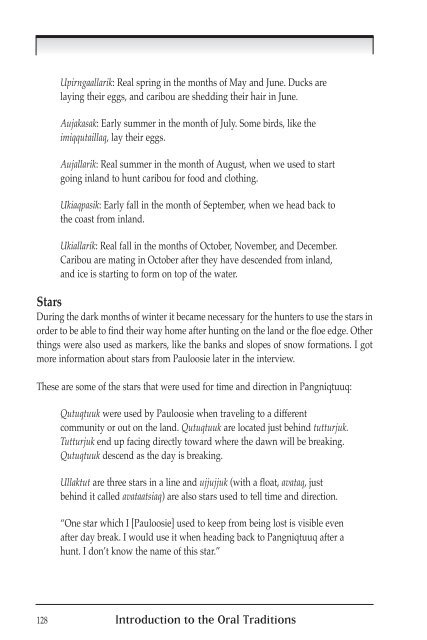Introduction-E
Introduction-E
Introduction-E
You also want an ePaper? Increase the reach of your titles
YUMPU automatically turns print PDFs into web optimized ePapers that Google loves.
Upirngaallarik: Real spring in the months of May and June. Ducks are<br />
laying their eggs, and caribou are shedding their hair in June.<br />
Aujakasak: Early summer in the month of July. Some birds, like the<br />
imiqqutaillaq, lay their eggs.<br />
Aujallarik: Real summer in the month of August, when we used to start<br />
going inland to hunt caribou for food and clothing.<br />
Ukiaqpasik: Early fall in the month of September, when we head back to<br />
the coast from inland.<br />
Ukiallarik: Real fall in the months of October, November, and December.<br />
Caribou are mating in October after they have descended from inland,<br />
and ice is starting to form on top of the water.<br />
Stars<br />
During the dark months of winter it became necessary for the hunters to use the stars in<br />
order to be able to find their way home after hunting on the land or the floe edge. Other<br />
things were also used as markers, like the banks and slopes of snow formations. I got<br />
more information about stars from Pauloosie later in the interview.<br />
These are some of the stars that were used for time and direction in Pangniqtuuq:<br />
Qutuqtuuk were used by Pauloosie when traveling to a different<br />
community or out on the land. Qutuqtuuk are located just behind tutturjuk.<br />
Tutturjuk end up facing directly toward where the dawn will be breaking.<br />
Qutuqtuuk descend as the day is breaking.<br />
Ullaktut are three stars in a line and ujjujjuk (with a float, avataq, just<br />
behind it called avataatsiaq) are also stars used to tell time and direction.<br />
“One star which I [Pauloosie] used to keep from being lost is visible even<br />
after day break. I would use it when heading back to Pangniqtuuq after a<br />
hunt. I don’t know the name of this star.”<br />
128 <strong>Introduction</strong> to the Oral Traditions


